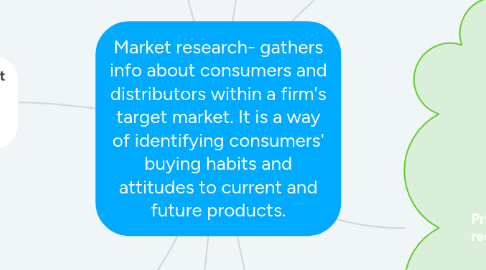
1. Qualitative research- in depth research into the motivation behind the attitudes and buying habits
1.1. Group discussions
1.1.1. led by psychologists among groups of 6-8
1.1.2. may reveal a problem or opportunity the company had not anticipated
1.1.3. reveal consumer psychology, such as the importance of image and peer pressure
1.2. Depth interviews-formal, in-depth interviews
1.2.1. have the same function as group discussion, but avoid the risk that the group opinion will be influenced by one ifluential person.
2. Quantitative research-pre-set questions on a large enough sample of people to provide statistically valid data.
2.1. assessing the validity of the results
2.2. writing a questionnaire that is unbiased and meets the research objectives
2.3. ensure that the research results are typical of the whole population, though only a sample population has been interviewed.
3. Limitations of market research
3.1. Samle size
3.1.1. the sample between 1000 and 1500 respondents are considered large enough to reflect the opinions of 45 million.
3.1.2. The number of people interviewed
3.2. Sample bias
3.2.1. A factor that causes research to be unrepresentative of the whole population.(bubbly interviewer or misleading survey questions )
4. Market segmentation
4.1. The process of dividing a broad consumer or business market, into sub-groups of consumers based on some type of shared characteristics.
4.2. To segment market: 1.Research a type of customer within a marketplace 2. See if they have common tastes 3. Identify the segment you wish to focus on 4. Devise a product designed for a particular segment
4.3. Multiple segmentation - a wide portfolio of niche brands can add up to a market-leading position.
5. Product and market orientation
5.1. A product-orientated apporoach to marketing: internal efficiency comes before consumer preferences.
5.1.1. Cutting costs and prices
5.1.2. Individualised sales targets, low basic salaries and high rates of commission ensure that sales stuff will be motivated to hit their targets, enabling the firm to sell the products.
5.2. A market-orientated business: managers take into account the needs of the consumers before making any decision.
6. Primary and secondary market research
6.1. The market reseach process: 1.Define the problem or reason; 2.Use secondary research to find out what info already exists; 3.Decide the primary research that you need; 4.Carry out the market research 5.Analyse the results; 6. ACT
6.2. Secondary market research: find data that already exists.
6.2.1. Can find out:1. Size of market; 2. Existing competitors;3.Trends in the market.
6.2.2. Methods: 1.Google 2.Newspapers 3.Government Statistic
6.3. Primary research: the process of collecting info directly from the people
6.3.1. Methods: 1.Survey 2.Questionnaires 3.Focus groups 4.Observations 5.Mystery shoppers
7. IT
7.1. Social media
7.1.1. bonding between consumer and brand
7.1.1.1. results in loyalty
7.1.2. There could be a bias
7.2. Databases
7.2.1. a huge database is very helpful

